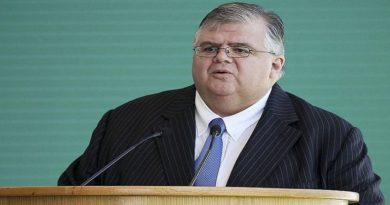A family united in action under Multilateral Environmental Agreements- Inger Andersen
United Nations Environment Programme (UNEP) Executive Director, Inger Andersen, in her speech at the ongoing sixth United Nations Environment Assembly (UNEA-6) Multilateral Environmental Agreements Day emphasized the importance of multilateral agreements in addressing the triple planetary crisis
Your Excellency Leila Benali, President of UNEA-6 and Minister of Energy Transition and Sustainable Development of Morocco,
CBD COP15 President, Your Excellency Mr Huang Runqiu, Minister of Environment, China,
Cheikh Ndiaye Sylla, COP 12 President of the Vienna Convention for the Protection of the Ozone Layer,
Ibrahim Thiaw, Under-Secretary-General and Executive Secretary of the United Nations Convention to Combat Desertification,
Dr. Rolph Payet, Executive Secretary, Basel, Rotterdam and Stockholm Conventions,
Dr. David Cooper, Acting Executive Secretary of the Secretariat of the Convention on Biological Diversity (CBD)
Dr. Susan Gardner, Director, Ecosystems Division, UNEP on behalf of the Regional Seas Conventions.
Colleagues and friends.
Welcome to the first Multilateral Environmental Agreement (MEA) Day to take place during a United Nations Environment Assembly.
It is fitting that we have gathered here in Nairobi during the sixth assembly, or UNEA-6. In a fragmented and divided world, UNEA is where environmental diplomacy brings unity. The Assembly is where we deliver inclusive multilateral solutions across the full triple planetary crisis: the crisis of climate change, the crisis of biodiversity loss and land loss, and the crisis of pollution and waste.
Most existing Multilateral Environmental Agreements have their genesis somehow in UNEP or UNEA’s predecessor, the Governing Council. UNEA and the resolutions and decisions it passes this week will help add impetus to the work of every global and regional deal on the environment. UNEA is here to lift you up.
The unity of environmental diplomacy in Nairobi goes beyond UNEA itself. This compound last year hosted important multilateral gatherings on climate science, on biodiversity, on plastics, and on ozone and climate-warming refrigerants. The growing movement to make important decisions in Nairobi also flows very much in line with the Rio+20 outcome, the Future We Want. This outcome committed to strengthening the role of UNEP as, and here I quote, “the leading global environmental authority that sets the global environmental agenda, promotes the coherent implementation of the environmental dimension of sustainable development within the United Nations system and serves as an authoritative advocate for the global environment”.
These are powerful words that were given by Member States to UNEP and us. As such, UNEA and UNEP offer up the platform for coherence that was sought at Rio+20. So, it is indeed inspiring to look around this room and see so many Multilateral Environmental Agreements here seeking greater coherence.
Friends,
I would like to say this is a family reunion, but the truth is that, over 50 years of environmental multilateralism, we have been fragmented. Scattered across the world. We have never been together. While we are obviously deeply grateful to the gracious hosts of members of the UNEP and environmental MEA family, distance in time and space does make achieving policy coherence more difficult.
Then again, they also say that absence makes the heart grow fonder. It is therefore with great fondness that today we welcome all members of the environmental MEA family. Because we are still a family, regardless of where we are based. A family that, when standing together, weaves the tapestry for a future that works for everyone, everywhere, on a healthy planet.
This family has grown since 1972. A year in which the World Heritage Convention was born. And the year in which UNEP was created. Shortly after, we saw the creation of the Convention on Migratory Species and the Convention on International Trade in Endangered Species of Flora and Fauna. In quick succession thereafter followed the Vienna Convention, the Montreal Protocol, and the Basel Convention – soon to be joined by the three Rio Conventions on climate, desertification and biodiversity. The arrival of the Rotterdam, Stockholm and Minamata Conventions significantly strengthened the chemicals and waste dimension. In tandem with these developments, we saw a large number of regional conventions being framed, the Regional Seas Conventions amongst them.
UNEP is privileged to host and administer the secretariats of over two dozen agreements, regional conventions and scientific panels. And more multilateral agreements, frameworks and initiatives keep coming online, whether hosted by UNEP or not. Last year, for example, saw the Global Framework on Chemicals and a deal on the conservation and sustainable use of marine biological diversity of areas beyond national jurisdiction. And, of course, negotiations on the plastics instrument are moving closer to the finishing line.
We are a big family. We are a growing family. This is, of course, a good thing. Each agreement has delivered successes. We have protected the ozone layer. Slowed the rate of climate change. Protected many species and huge areas of land and sea. Raised the profile of desertification and land degradation action. Eliminated toxic substances dangerous to human and planetary health. I thank you all for your efforts and commitment.
But, Dear siblings and cousins, we know that the triple planetary crisis is still accelerating. We must do more. And we can only do more if we act as one. Because action on climate is action on biodiversity and land; because action on land is action on climate; because action on chemicals, pollution and waste is action on nature and on climate. These conventions are, without a doubt, indivisible. As indivisible as the earth’s systems are indivisible.
Look, you have, I am sure, heard me compare Multilateral Environmental Agreements to threads in a tapestry, woven together to create the big picture of a stable climate, of healthy nature, of thriving lands and of a pollution-free planet. This is true. Each thread is, in and of itself, strong. But it is my view that the threads are not bound together as tightly they should be. In some places, they fret a little against each other. In others they are knotted. The result is that the big picture of our common tapestry does not stand out as sharply as it could. I invited you to this UNEA so that we may bind ourselves closer together, bring the big picture into a focus and make it a reality. And this is a standing invitation for future UNEAs.
As I said earlier, time apart ignites passion anew. Because indeed, as Shakespeare writes so beautifully in Sonnet 98, “From you I have been absent in the spring”. We have been absent. Now we are together, in the Nairobi summer. Let us not just be together here, but present here. Passionate for something new and better. Let us exchange ideas and find ways to be more than the sum of our parts – as all great and close families do.
So, be inspired by the nature that surrounds you here at the UNEP Headquarters. Be blessed by the rains you saw yesterday. Let the Nairobi spirit that has filled these rolling hills so many times over the past five decades swell inside you. See each other as allies and confidantes. Lift each other up. And become one family, so that we may all live together on a healthy and thriving planet that serves everyone’s needs.




